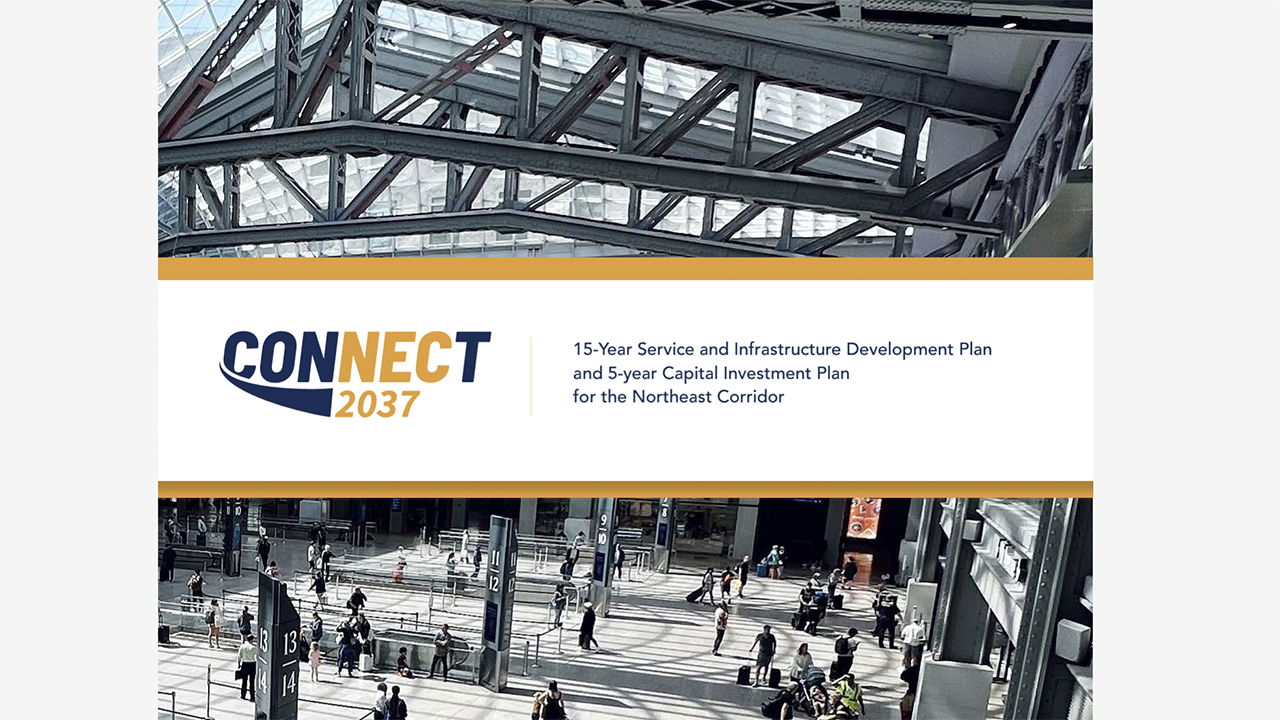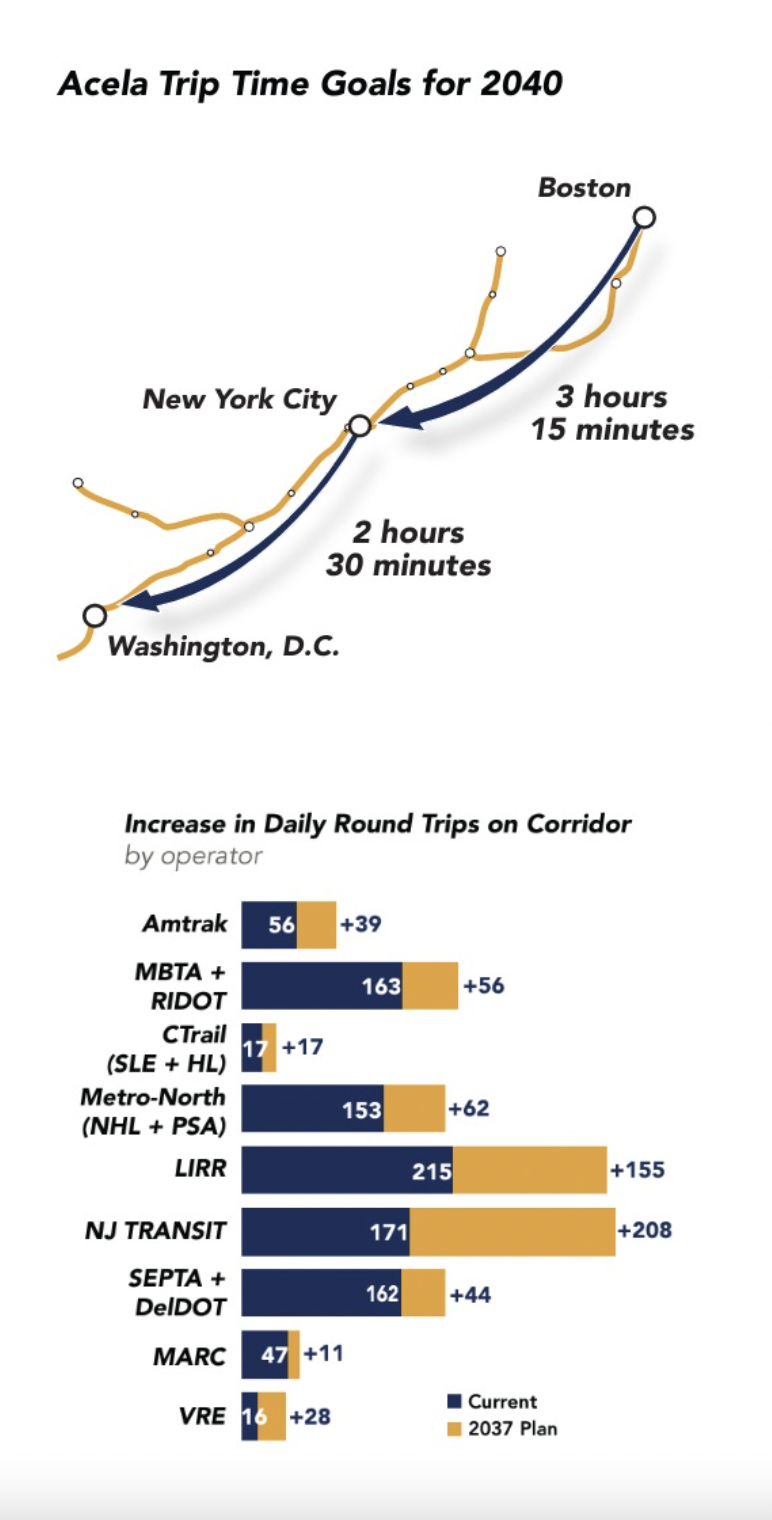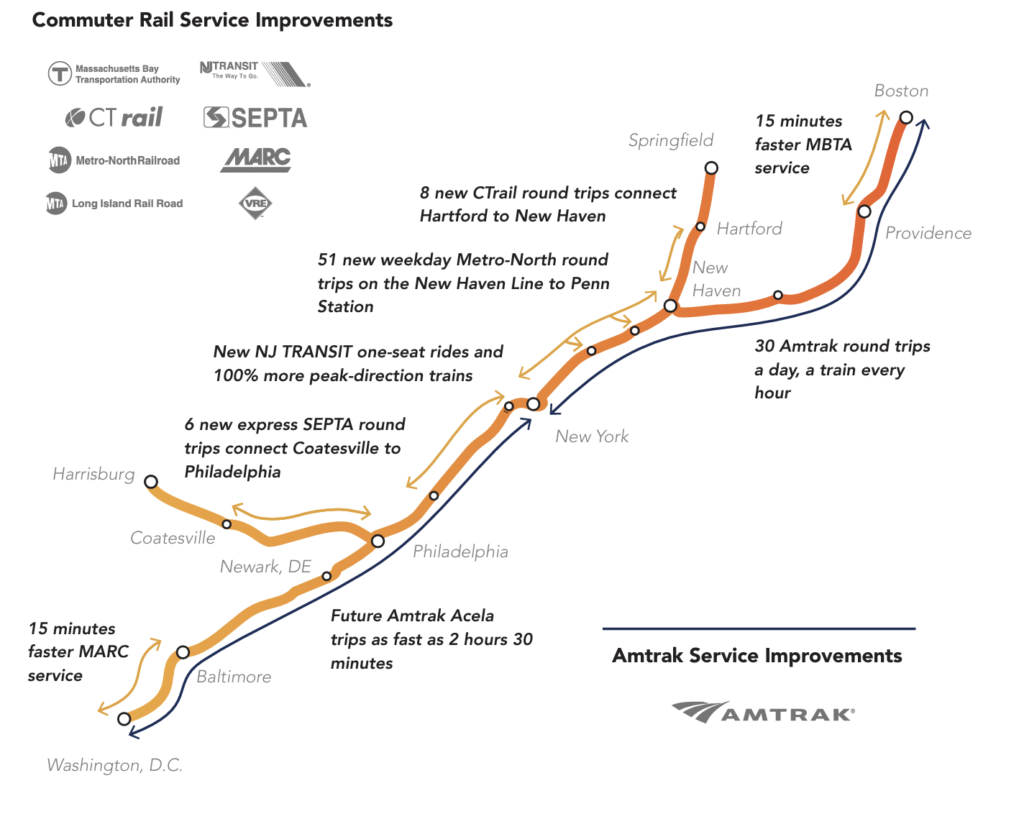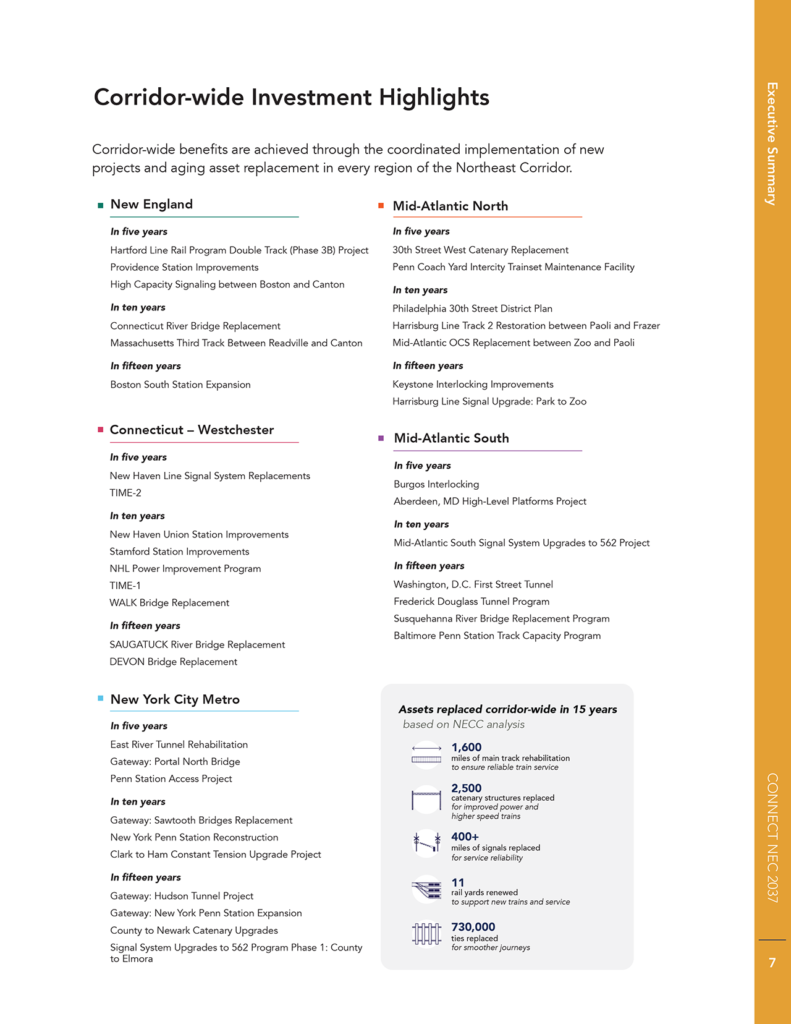
Northeast Corridor Commission Releases CONNECT NEC 2037
Written by Marybeth Luczak, Executive Editor
The Northeast Corridor Commission on Nov. 16 issued CONNECT NEC 2037 (C37), which identifies long-term service objectives and associated capital investments over the next 15 years along the 457-mile NEC (Northeast Corridor), which serves the nation’s most densely populated region and supports a $3 trillion economy.
The CONNECT NEC program is described as a planning process that integrates investments across four infrastructure owners (Amtrak, Massachusetts Bay Transportation Authority/MBTA, Connecticut Department of Transportation, and MTA Metro-North Railroad) and nine passenger rail operators (Amtrak, MBTA, CTrail, MTA Metro-North Railroad, MTA Long Island Rail Road/LIRR, New Jersey Transit, Southeastern Pennsylvania Transportation Authority, Maryland Area Regional Commuter/MARC and Virginia Railway Express). The $16.4 billion in Federal-State Partnership for Intercity Passenger Rail grants recently awarded by the Federal Railroad Administration (FRA) will help advance C37 (download below) and serve as a down payment to start rebuilding the NEC. C37 is slated to address aging infrastructure, create capacity for additional service, and build a resilient railroad network for the future.
The total cost to implement C37 is estimated to be $135 billion in 2023 dollars or, accounting for inflation, $175 billion in year-of-expenditure dollars, according to the Commission, which was established by Congress in 2008 (49 U.S.C. §24905) “to develop coordinated strategies to improve the Northeast’s core rail network in recognition of the inherent challenges of planning, financing, and implementing major infrastructure improvements that cross multiple jurisdictions.” Of that amount, approximately 40% is funded through existing or expected federal, state and local sources, leaving a funding gap of about $100 billion for the full C37. More than a third of the available funding for C37 is expected to be provided by the Federal-State Partnership for Intercity Passenger Rail grant program. The remainder is funded by federal discretionary grants from the Consolidated Rail Infrastructure and Safety Improvements (CRISI) Program and Capital Investment Grants Program, Amtrak’s annual grants, capital contributions through the Commission’s Cost Allocation Policy, and state and local funding. Without predictable funding beyond FY26, agencies may not be able to commit to the necessary long-term investments in project development and design, workforce development, and equipment procurement needed to advance projects, the Commission said.

C37 is an update to C35, completed in 2021, which assessed NEC-wide rail service and state-of-good-repair goals and the infrastructure investments necessary to meet them. “C35’s level of collaboration and credibility encouraged Congress to allocate historic levels of funding for the NEC in BIL [the Bipartisan Infrastructure Law],” the Commission reported. “C37 defines the plan in much greater detail, updates service goals based on new travel trends, provides additional analysis of workforce and other resource constraints, and refines future funding needs.”
If fully funded and implemented, the Commission said the C37 plan “will rebuild the corridor’s critical infrastructure, resulting in faster, more reliable, and more frequent trains; new connections for underserved communities and new markets; new jobs; and more resilient, sustainable infrastructure,” including:
• More frequent Amtrak service on modern trainsets and expanded commuter rail services.
—50% more Amtrak trains between Boston and New York.
—Nearly 100% more Amtrak service between New York and Washington, D.C.
—60% more commuter trains, making rail travel more attractive to both existing and new riders.
—MBTA riders will travel from Boston to Providence, R.I., in less than an hour.
—MTA Metro-North Railroad riders will have 51 new weekday round-trips to Penn Station on the New Haven (Conn.) Line.
—MARC commuter rail service between Washington, D.C., and Baltimore, Md., will increase from 27 to 37 round-trips per day.

• Expanded access to downtowns, housing and opportunities.
—More than 300,000 households within 15 minutes of new stations will be better connected to the NEC than they are today, including communities in the Bronx, N.Y.; along the Hartford (commuter rail) Line in Connecticut; North Brunswick, N.J.; and Elkton and southeast Baltimore, Md.
—NEC riders will also have new one-seat MTA Metro-North Railroad service between New York City and Waterbury, Conn., and new hourly one-seat Amtrak service between New York City; Hartford, Conn.; and Springfield, Mass.
• Job and career opportunities.

—C37 investment will support more than 900,000 jobs over 15 years throughout the United States, including direct jobs that will execute projects, indirect jobs that provide goods and services to support construction, and induced jobs generated by the personal spending of direct and indirect employees.
• Reduced greenhouse gas emissions by moving more people by train.
—Enhanced NEC rail services will accommodate 51 million more riders each year, shifting approximately 38 million annual car trips and nearly 600,000 short-haul plane trips to rail.
—Up to 750,000 metric tons of greenhouse gas (GHG) emissions will be eliminated annually from new riders choosing rail.
• A resilient rail network for a changing climate.
—C37 investments in the corridor will keep riders “moving reliably” by addressing delays and cancellations due to flooding, extreme heat, severe weather events, or infrastructure failures.

According to the Commission, project sponsors “will manage the planning, design, and delivery of individual projects in C37. However, there are significant challenges associated with project delivery on a complex railroad network with multiple operators providing a high level of service.” The Commission said it has launched an Implementation Coordination Program (ICP) “to facilitate improved project delivery and enable the successful implementation of CONNECT NEC.” While participating in the ICP, Commission members are said to be “examining new delivery methods, balancing the need to invest with the potential impact on customers during construction.” According to the Commission, it is also “critical to understand resource needs and resource availability across the entire program to establish realistic schedules for the development, design, and construction of individual projects. Amtrak and other NEC infrastructure owners have been advancing aggressive workforce hiring and training programs to increase railroad staff available to deliver these unprecedented capital programs. Commission members will continue to investigate innovative approaches to meeting workforce needs.”
“The region coming together behind a unified plan for the NEC was a key factor in securing money for the corridor through the Bipartisan Infrastructure Law,” New Jersey Transit President and CEO and NEC Commission Co-Chair Kevin S. Corbett said. “We are ready to rebuild after decades of woefully insufficient investment.The projects in this plan will create jobs, grow the economy, and improve the lives of the hundreds of thousands of New Jersey residents who depend on New Jersey Transit and Amtrak services.”
“The Northeast Corridor is vital to hundreds of thousands of Americans and the American economy, and investing in it is a priority of the Biden-Harris Administration,” said Amit Bose, FRA Administrator and Co-Chair of the NEC Commission. “Major projects are now receiving federal support, with the Federal Railroad Administration recently awarding $16.4 billion to 25 NEC projects through our Federal State Partnership Program. Projects like the Hudson River Tunnel have entered engineering with $6.8 billion through the Federal Transit Administration’s Capital Investment Grant Program. The NEC represents infrastructure of national significance, and we look forward to working with Amtrak and state partners to maximize funding in President Biden’s Bipartisan Infrastructure Law and to advance projects that reduce delays, allow for increased speeds, and make trips more reliable and convenient for riders. Coordination is necessary and important in this effort, and I applaud the Northeast states and Amtrak for coming together through the NEC Commission to ensure continued progress on America’s busiest rail corridor.”
“A modern, reliable Northeast Corridor is essential to the region’s economic future,” Amtrak CEO Stephen Gardner said. “Amtrak ridership on the Northeast Corridor is at all-time record levels, and the projects included in this plan will provide the capacity, reliability, and service improvements that our customers need and deserve.”
“For transit riders all along the East Coast, the Northeast Corridor is a critical connection that expands their community from one neighborhood to an entire region,” Federal Transit Administrator Nuria Fernandez said. “The C37 plan is essential to protect and improve those opportunities.”



